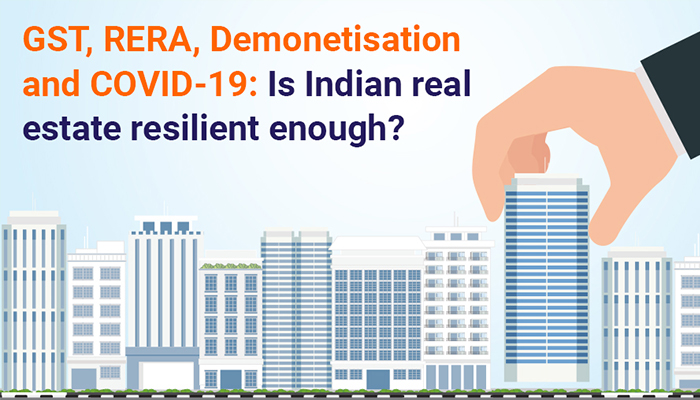The Indian Real Estate Market - Future and Challenges

The introduction of GST, application of RERA, demonetisation and the COVID-19 pandemic are some of the many challenges that the Indian real estate segment has faced in recent years. The real estate market has been struggling with all the primary factors of production including land, labour and capital. However, the quarterly housing sales in Q1 2022 were at an all-time high since 2015 showcasing how the real estate has managed to bounce back despite the hurdles.
The following are some of the key challenges that the realtors have been facing in the current market scenario:
Increased Prices of Construction Materials
For a real estate developer, construction materials make up the majority of the overall cost required for real estate development. The costs of these materials have recently witnessed a dramatic increase, including the cost of essential materials like cement and steel. The global shortage of raw materials is the main factor contributing to the price increase. Moreover, rising fuel costs have driven up the logistical costs, pushing up the entire cost of the materials and as a result real estate.
Some real estate agents in Mumbai and also in other cities across the nation worry that real estate construction might have to be put on hold as a result of the rise in raw material prices. Mid-market and small developers are already operating with extremely limited margins post-COVID in order to remain competitive. In an attempt to sustain themselves, they will be forced to raise the pricing and pass the cost on to the customers. The increased property values are anticipated to cause a rise in rental costs as well.
Dependency on Physical Labour
The real estate industry has placed a significant emphasis on manual labor-intensive traditional construction methods. Real estate has experienced difficulties due to a lack of skilled blue-collar labour. Due to the real estate industry's heavy reliance on manual labour, the pandemic caused a standstill in the building industry. Project delays are brought about by low labour productivity and a labour scarcity. Industry estimates indicate that there is a 15–25% labour shortfall at the moment.
Lack of Funding
The time-taking nature of construction necessitates the need of funding for new small scale developers. But developers have always faced difficulties in availing funds from banks and financial institutions. Decisions are framed on the basis of speculative cash flows. As a result, the financial institutions typically exercise great care and consume a lot of time while reviewing loan application. Due to unavailability of funding and insufficient finance, many realtors actually fail to execute projects on time.
Coronavirus Pandemic and Work From Home Culture
As the COVID-19 pandemic hit the nation, the Indian real estate market suffered hugely. Various corporates and companies adopted the work from home culture to ensure social distancing amid the lockdown. This remote model of working led to a decline in the demand for property in metro cities. As a result, the rental business also witnessed a massive hit. According to research, there was a decline of 14 percent year-on-year sales during the July-September 2020 period. The situation has now improved, and companies are slowly opening up. Still, a lot of companies are functioning on work from home models.
Unavailability of Land
Acquiring land for new projects by developers is a big challenge in India considering the land is not freely available and substantial parts of land are under government ownership. Moreover, the property rates are high, making it difficult for small developers to attain sufficient capital to be able to invest in land.
Tackling these challenges faced by the Indian real estate requires the need to devise innovative solutions that will lead the next phase of growth for residential real estate markets.
Tags
Disclaimer: The information contained in this post is for general information purposes only. IIFL Home Finance Limited (including its associates and affiliates) ("the Company") assumes no liability or responsibility for any errors or omissions in the contents of this post and under no circumstances shall the Company be liable for any damage, loss, injury or disappointment, etc. suffered by any reader. All information in this post is provided "as is", with no guarantee of completeness, accuracy, timeliness, or of the results, etc. obtained from the use of this information, and without warranty of any kind, express or implied, including, but not limited to warranties of performance, merchantability, and fitness for a particular purpose. Given the changing nature of laws, rules, and regulations, there may be delays, omissions, or inaccuracies in the information contained in this post. The information on this post is provided with the understanding that the Company is not herein engaged in rendering legal, accounting, tax, or other professional advice and services. As such, it should not be used as a substitute for consultation with professional accounting, tax, legal or other competent advisers. This post may contain views and opinions which are those of the authors and do not necessarily reflect the official policy or position of any other agency or organization. This post may also contain links to external websites that are not provided or maintained by or in any way affiliated with the Company and the Company does not guarantee the accuracy, relevance, timeliness, or completeness of any information on these external websites. Any/ all (Home/ Loan Against Property/ Secured Business Loan/ Balance Transfer/ Home Improvement Loan/ NRI Home Loan/ Home Loan for Uniformed Services) loan product specifications and information that may be stated in this post are subject to change from time to time, readers are advised to reach out to the Company for current specifications of the said (Home/ Loan Against Property/ Secured Business Loan/ Balance Transfer/ Home Improvement Loan/ NRI Home Loan/ Home Loan for Uniformed Services) loan.
 Login
Login






















